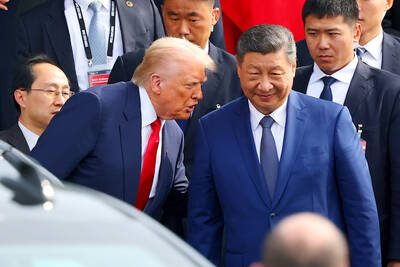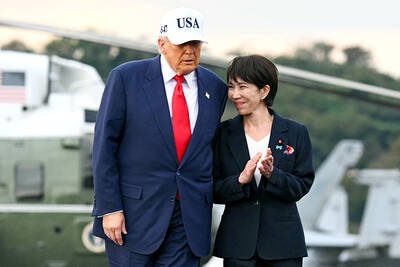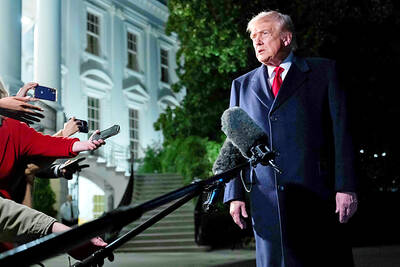The US could defend Taiwan from a Chinese military attack, but defeating a Chinese invasion force is likely to become increasingly difficult in coming years, a report from the RAND Corporation said.
“As long as the Chinese economy continues to grow faster than that of the US and Beijing continues to make military modernization a priority, the challenges facing US military planners in Asia will grow more severe over time,” the report said.
The 400-page report was released just one week before Chinese President Xi Jinping (習近平) is to arrive in the US for a state visit and a summit with US President Barack Obama, which might ensure that its contents are given close attention in Beijing.
In the case of a Chinese attack on Taiwan, US commanders would probably be unable to find the basing required for US forces “to prevail in a seven-day campaign,” said the report, titled The US-China Military Scorecard: Forces, Geography and the Evolving Balance of Power.
It predicts they would prevail in a longer campaign, but this would entail leaving ground and naval forces vulnerable to Chinese air operations.
The report said that given the size and technical sophistication of the US arsenal, together with the accumulated experience and resiliency of its military personnel and commanders, the US remains capable of fighting and winning a protracted air and naval battle against China.
The report examines what RAND analysts consider to be the two most likely war scenarios: an attack on Taiwan and occupation of the disputed Spratly Islands (Nansha Islands, 南沙群島).
“The Spratly Islands scenario would be easier, requiring roughly half the forces of the Taiwan scenario,” the report said.
An invasion could be brought about after a more assertive China moves to isolate Taiwan further on the world stage, inadvertently pushing Taipei toward de jure independence, the report said.
Chinese leaders would then decide to occupy the nation by force, prompting Taiwan to appeal for US help, the report said, adding that “given the ambiguous circumstances of conflict, Washington decides to use military force to protect the island.”
The scenario assumes that, as tensions mount, both sides prepare militarily.
The People’s Liberation Army (PLA) could deploy additional combat and support aircraft to the Nanjing Military Region, deploy its most advanced submarines and move forces out of garrison to forward staging areas.
The US might then react by moving additional aircraft and ships to the region and raise alert levels.
Politically, the scenario assumes that the US is allowed to operate freely from bases in Japan, the PLA is permitted to strike US bases in Japan and US forces are allowed to attack nonstrategic targets in China.
The report said little in detail about the role of Republic of China forces in defending Taiwan.
“Taiwanese ability to extend the duration of a contest has a substantial impact,” it said. “To the extent that Taiwan can prolong the duration of the conflict, US force requirements could be eased.”
“It is easier for the US to employ its air and naval power to influence events on the ground in a longer war than in a shorter one. The US should strongly encourage Taiwan to undertake defense reforms that will maximize its odds of avoiding quick defeat,” the report said.
According to the report, China would aim to disrupt US forward operating bases near the conflict zone, primarily through missile strikes, while attempting to sink US aircraft carriers or push back their areas of operation using submarines, missiles and air attacks.
The US would seek to gain air superiority through both air-to-air battles and by penetrating Chinese airspace to strike air defense targets and command-and-control facilities.
“The US would also seek to destroy Chinese surface assets, including forces dedicated to landing operations and surface action groups operating in an air defense or anti-submarine capacity,” the report said. “It would likely also undertake limited counter-space and cyber operations, especially if it were attacked first in those domains.”
“Neither side would look to use nuclear weapons at the start of hostilities, but the security of nuclear forces would weigh heavily on leaders’ minds during a conflict and under some circumstances pressures could build to cross the nuclear threshold,” it said.
According to the RAND analysts, for China to prevail in either the Taiwan or Spratlys scenarios, its offensive goals would require it to hold advantages in nearly all operational categories simultaneously.
“US defensive goals could be achieved by holding the advantage in only a few areas. Nevertheless, China’s improved performance could raise costs, lengthen the conflict and increase risks to the US,” the report said.
The report said that improved accuracy of Chinese ballistic missiles would force a large proportion of US aircraft to fly from bases susceptible to attack or farther from the conflict.
“Basing issues will pose greater challenges for US efforts to gain air superiority over the battlefield,” the report said.
The report said that while penetrating Chinese airspace has become more hazardous “especially in the high-threat environment opposite Taiwan,” the development of new generations of precision weapons gives the US “new options and greater punch.”
RAND analysts modeled attacks on the 40 Chinese air bases within unrefueled fighter range of Taiwan and the smaller number near the Spratlys and concluded the US could close them for two or three days in an initial attack.
US submarines could be expected to destroy almost 40 percent of Chinese amphibious shipping — tasked with landing troops on Taiwan during a seven-day campaign — “losses that would likely wreck havoc on the organizational integrity of a landing force,” the report said.
The report said China enjoys the advantage of proximity in most plausible conflict scenarios, and geographical advantage would likely neutralize many US military strengths, so US military leaders should ensure that US planning for Pacific military operations is “as dynamic as possible.”
“Western governments and commentators should make it clear to China that aggression would carry immense risks and that China should be cautious not to exaggerate its ability to prevail in armed conflict,” it said.

UKRAINE, NVIDIA: The US leader said the subject of Russia’s war had come up ‘very strongly,’ while Jenson Huang was hoping that the conversation was good Chinese President Xi Jinping (習近平) and US President Donald Trump had differing takes following their meeting in Busan, South Korea, yesterday. Xi said that the two sides should complete follow-up work as soon as possible to deliver tangible results that would provide “peace of mind” to China, the US and the rest of the world, while Trump hailed the “great success” of the talks. The two discussed trade, including a deal to reduce tariffs slapped on China for its role in the fentanyl trade, as well as cooperation in ending the war in Ukraine, among other issues, but they did not mention

Japanese Prime Minister Sanae Takaichi yesterday lavished US President Donald Trump with praise and vows of a “golden age” of ties on his visit to Tokyo, before inking a deal with Washington aimed at securing critical minerals. Takaichi — Japan’s first female prime minister — pulled out all the stops for Trump in her opening test on the international stage and even announced that she would nominate him for a Nobel Peace Prize, the White House said. Trump has become increasingly focused on the Nobel since his return to power in January and claims to have ended several conflicts around the world,

REASSURANCE: The US said Taiwan’s interests would not be harmed during the talk and that it remains steadfast in its support for the nation, the foreign minister said US President Donald Trump on Friday said he would bring up Taiwan with Chinese President Xi Jinping (習近平) during a meeting on the sidelines of the APEC Summit in South Korea this week. “I will be talking about Taiwan [with Xi],” Trump told reporters before he departed for his trip to Asia, adding that he had “a lot of respect for Taiwan.” “We have a lot to talk about with President Xi, and he has a lot to talk about with us. I think we’ll have a good meeting,” Trump said. Taiwan has long been a contentious issue between the US and China.

Taiwan’s first African swine fever (ASF) case has been confirmed and would soon be reported to the World Organization for Animal Health (WOAH), Minister of Agriculture Chen Junne-jih (陳駿季) yesterday. The Ministry of Agriculture’s Veterinary Research Institute yesterday completed the analysis of samples collected on Tuesday from dead pigs at a hog farm in Taichung and found they were ASF-positive. Animal and Plant Health Inspection Agency Animal Quarantine Division chief Lin Nien-nung (林念農) said the result would be reported to the WOAH and Taiwan’s major trade partners would also be notified, adding that pork exports would be suspended. As of Friday, all samples